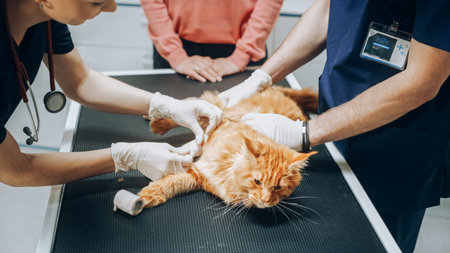Introduction to Animal-Assisted Therapy
Animal-assisted therapy (AAT) is rapidly gaining traction as an innovative approach in American healthcare, offering a unique blend of comfort, motivation, and emotional support. Rooted in the belief that animals can play a powerful role in human healing, AAT involves structured interactions between patients and specially trained animals—most commonly dogs, but also cats, horses, and even rabbits or birds. The origins of animal-assisted therapy trace back to the 1960s when Dr. Boris Levinson, a child psychologist, observed remarkable improvements in his young patients’ communication skills when his dog was present during sessions. Since then, AAT has evolved from an experimental concept into a respected adjunct to traditional therapies in hospitals, nursing homes, rehabilitation centers, and schools across the United States. As more Americans seek holistic and patient-centered care, animal-assisted therapy’s popularity continues to rise, reshaping the way we think about healing and wellbeing.
2. How Animal Companions Help Heal: The Science Behind the Therapy
Animal-assisted therapy (AAT) is more than just a feel-good trend—it is rooted in scientific research demonstrating measurable benefits to both mental and physical health. Studies conducted across the United States have highlighted how interactions with animals can trigger complex psychological and physiological responses that promote healing. When a person interacts with a therapy dog, cat, or even a miniature horse, their brain releases oxytocin—a hormone associated with bonding and stress reduction. This “feel-good” chemical response helps decrease cortisol levels (the body’s main stress hormone), leading to lower blood pressure and heart rate.
But the science behind AAT goes deeper. According to research from the UCLA Health Department, patients who engaged with therapy animals before medical procedures experienced significantly reduced anxiety compared to those who did not. Another U.S.-based study published in the journal “Frontiers in Psychology” found that veterans participating in animal-assisted interventions reported lower rates of post-traumatic stress symptoms, improved mood, and greater overall well-being.
Key Psychological & Physiological Mechanisms
| Mechanism | Description | U.S. Study Example |
|---|---|---|
| Oxytocin Release | Increases feelings of trust and relaxation | UCLA Health: Patients showed higher oxytocin after interacting with dogs |
| Cortisol Reduction | Lowers stress and anxiety levels | NIH-funded research: Children in hospitals had reduced cortisol when visited by therapy dogs |
| Improved Heart Rate Variability | Supports cardiovascular health and resilience to stress | Mayo Clinic: Cardiac patients saw better recovery outcomes with pet visitation programs |
Social Connection and Emotional Support
Animals naturally encourage social interaction, which is crucial for emotional healing. For example, therapy dogs used in group therapy sessions have been shown to help individuals open up more readily, facilitating conversations that might otherwise be difficult. This effect is especially prominent in American hospitals, nursing homes, and schools where loneliness or isolation can hinder recovery.
The Takeaway for Healthcare Providers
The mounting evidence underscores why AAT is being adopted in mainstream healthcare settings across the U.S.: its ability to address both mind and body through scientifically validated mechanisms makes it a powerful adjunct to traditional treatments.

3. Applications in Modern Healthcare Settings
Animal-assisted therapy (AAT) has rapidly found its place in a variety of American healthcare environments, transforming how patients receive care and support. In hospitals across the United States, therapy dogs and other animals are brought into patient rooms, waiting areas, and even intensive care units to help reduce anxiety, provide comfort, and promote healing. These visits often result in visible improvements in patient mood and a reduction in perceived pain levels, making AAT a valuable complement to traditional medical treatments.
Rehabilitation centers have also embraced animal-assisted therapy as a powerful motivator for patients recovering from injuries or surgeries. By engaging with therapy animals during physical or occupational therapy sessions, patients are often more motivated to participate in exercises and reach their recovery goals. The presence of an animal can make repetitive or challenging tasks feel less daunting, which leads to better outcomes and higher patient satisfaction.
Nursing homes and long-term care facilities utilize AAT to address the emotional and social needs of residents. Many elderly individuals struggle with loneliness, depression, or cognitive decline; regular visits from trained therapy animals can spark conversations, evoke memories, and foster a sense of connection. For residents with dementia or Alzheimer’s disease, interacting with animals can stimulate memory recall and provide moments of joy that significantly enhance quality of life.
Mental health clinics throughout America are increasingly incorporating animal-assisted therapy into their treatment plans for conditions such as PTSD, anxiety disorders, and depression. Animals offer nonjudgmental companionship that helps clients open up during counseling sessions or cope with overwhelming emotions. Some clinics even have resident therapy animals that become familiar faces for clients attending ongoing treatment. This human-animal bond is proving to be a vital tool in helping individuals manage stress, build trust, and develop healthier coping mechanisms.
Benefits for Patients and Healthcare Providers
Animal-assisted therapy (AAT) is making waves in American healthcare by offering a broad range of benefits that touch both patients and the professionals who care for them. The presence of therapy animals isn’t just a feel-good story—it’s increasingly backed by science, with studies demonstrating real improvements in emotional, mental, and physical health outcomes.
Emotional and Mental Health Benefits for Patients
Many patients report feeling less anxious, lonely, or depressed after sessions with therapy animals. Interacting with a dog, cat, or even a miniature horse can break through feelings of isolation, especially for those undergoing long hospital stays or struggling with chronic conditions. AAT also helps reduce stress hormones like cortisol while boosting feel-good chemicals such as oxytocin and dopamine. This shift in brain chemistry can lead to better mood stability, increased motivation to participate in rehabilitation, and more positive outlooks on recovery.
Physical Health Improvements
| Benefit | Description |
|---|---|
| Lower Blood Pressure | Petting or interacting with animals has been shown to lower blood pressure and heart rate. |
| Pain Management | AAT can distract from pain and discomfort, helping reduce the need for medication. |
| Increased Physical Activity | Walking or playing with therapy animals encourages movement, which is vital in rehabilitation settings. |
Positive Effects on Healthcare Staff and Caregivers
The benefits of animal-assisted therapy extend beyond patients. Nurses, doctors, therapists, and caregivers often face high levels of stress and burnout. The presence of therapy animals provides much-needed moments of relief during demanding shifts. Staff members report improved morale, decreased anxiety, and a greater sense of camaraderie when animals are part of the care environment.
Summary Table: Impact on Patients vs. Providers
| Patients | Healthcare Providers | |
|---|---|---|
| Emotional Wellbeing | Reduced anxiety and depression; increased comfort | Improved job satisfaction; lower stress levels |
| Mental Health | Better engagement in therapy; positive outlooks on recovery | Stronger team dynamics; enhanced empathy toward patients |
| Physical Health/Wellness | Lower blood pressure; increased mobility; pain relief | Decreased burnout risk; improved workplace atmosphere |
Real Stories Make an Impact
A growing number of hospitals across the United States are sharing success stories where AAT has not only lifted patient spirits but also transformed the entire healthcare setting into a more compassionate space. Whether it’s a child in pediatric oncology smiling for the first time in days or a nurse finding renewed energy during a tough shift, animal-assisted therapy is proving its value as a powerful tool in modern healthcare.
5. Challenges and Ethical Considerations in the U.S.
While animal-assisted therapy is making significant strides in healthcare, it also faces several challenges and ethical considerations unique to the United States. One of the primary concerns is animal welfare; ensuring that therapy animals are treated humanely and not subjected to undue stress is paramount. Organizations must adhere to strict guidelines regarding working hours, living conditions, and veterinary care for their animals to maintain their health and well-being. Another important consideration is allergies—many Americans suffer from pet allergies, which can cause discomfort or even severe reactions in clinical settings. Facilities must implement protocols to minimize exposure and protect patients who may be sensitive. Safety is another concern, as even well-trained animals can sometimes act unpredictably, especially around vulnerable populations such as children or the elderly. Proper screening, training, and supervision are essential to mitigate risks associated with bites or scratches. Additionally, cultural perceptions of animals vary widely across American society; while some individuals may find comfort and healing in animal presence, others may feel uncomfortable or fearful due to personal beliefs or past experiences. Healthcare providers must respect these differences and offer alternative therapies when needed. Balancing these concerns with the proven benefits of animal-assisted interventions requires ongoing dialogue between healthcare professionals, animal handlers, and patients to ensure ethical standards are maintained and everyone’s needs are respected.
6. Real-Life Success Stories
Across the United States, animal-assisted therapy is making a profound difference in healthcare settings, as demonstrated by inspiring real-life success stories. For instance, at UCLA Medical Center, therapy dogs regularly visit pediatric oncology wards, helping young patients manage pain and anxiety during challenging treatments. In one remarkable case, a child undergoing chemotherapy showed significant improvement in mood and appetite after frequent sessions with a golden retriever named Hope.
Veterans Affairs hospitals have also embraced animal-assisted interventions, particularly for veterans struggling with PTSD. At the VA Palo Alto Health Care System, equine therapy has helped veterans regain confidence and reduce symptoms of depression. One veteran credited his participation with a therapy horse for helping him reconnect with his family after years of emotional withdrawal.
Nursing homes across Florida have implemented cat and rabbit therapy programs to combat loneliness among elderly residents. Staff at The Palms Nursing Home reported that interactions with their resident therapy cat led to decreased agitation and improved communication in seniors living with dementia.
Even in high-stress emergency rooms, therapy animals provide comfort not only to patients but also to healthcare workers coping with burnout. At Boston Children’s Hospital, weekly visits from certified therapy dogs have become a cherished routine for both staff and families facing medical crises.
These diverse examples underscore how animal-assisted therapy is transforming patient care throughout the U.S., offering hope, comfort, and tangible health benefits to people of all ages and backgrounds.
7. The Future of Animal-Assisted Therapy in American Healthcare
Looking ahead, animal-assisted therapy (AAT) is poised to become an even more integral part of the American healthcare landscape. Ongoing research is exploring not only the psychological benefits but also the physiological impacts of interactions with therapy animals, including lowered blood pressure, improved heart health, and enhanced immune responses. As clinical trials and large-scale studies continue, evidence-based protocols are being developed to standardize best practices for AAT across various medical and therapeutic settings.
Emerging trends suggest that technology will play a growing role in expanding access to AAT. Virtual sessions featuring therapy animals are already gaining traction, providing comfort and companionship to patients who are homebound or living in remote areas. Additionally, there is a push toward diversifying the types of animals involved in therapy—beyond dogs and cats—to include rabbits, horses, birds, and even miniature pigs, each offering unique therapeutic benefits.
The continued integration of AAT nationwide is also supported by advocacy from professional organizations and healthcare providers who recognize its value in holistic care. Many hospitals, veterans’ programs, schools, and eldercare facilities are establishing permanent animal-assisted therapy teams as part of their standard services. Looking forward, we can expect increased funding for AAT research, expanded training programs for handlers and healthcare professionals, and greater insurance coverage for these innovative therapies.
Ultimately, as Americans place increasing emphasis on mental wellness and patient-centered care, animal-assisted therapy stands at the forefront of this revolution—bridging science and compassion to shape a healthier future for all.

